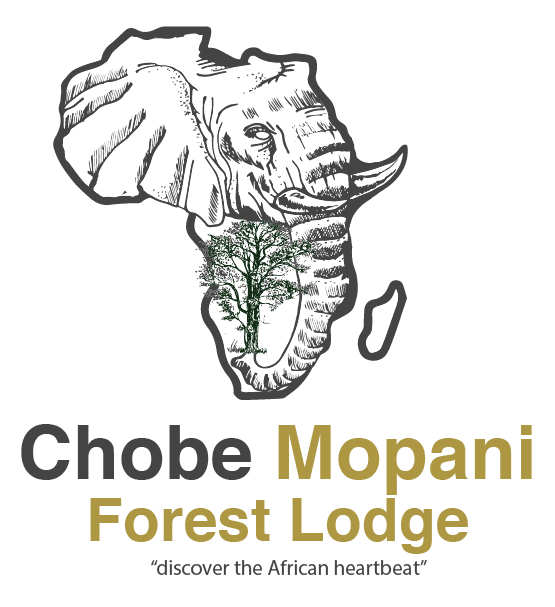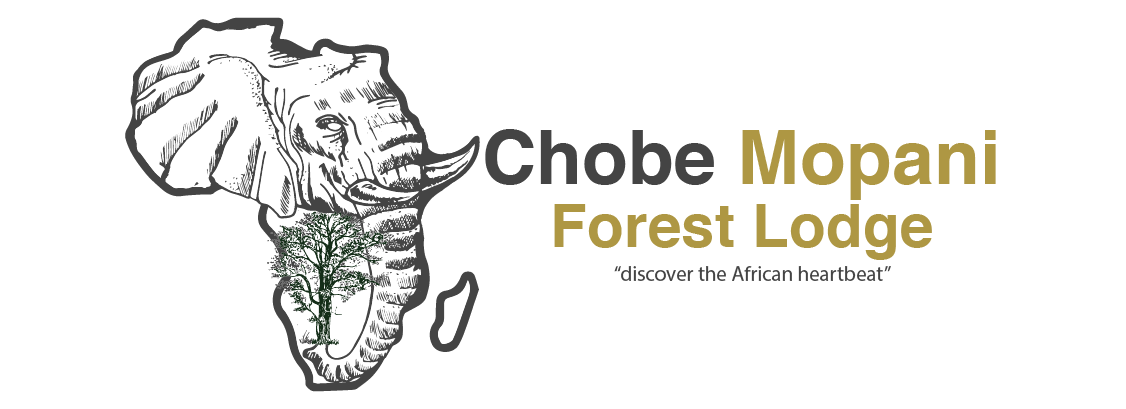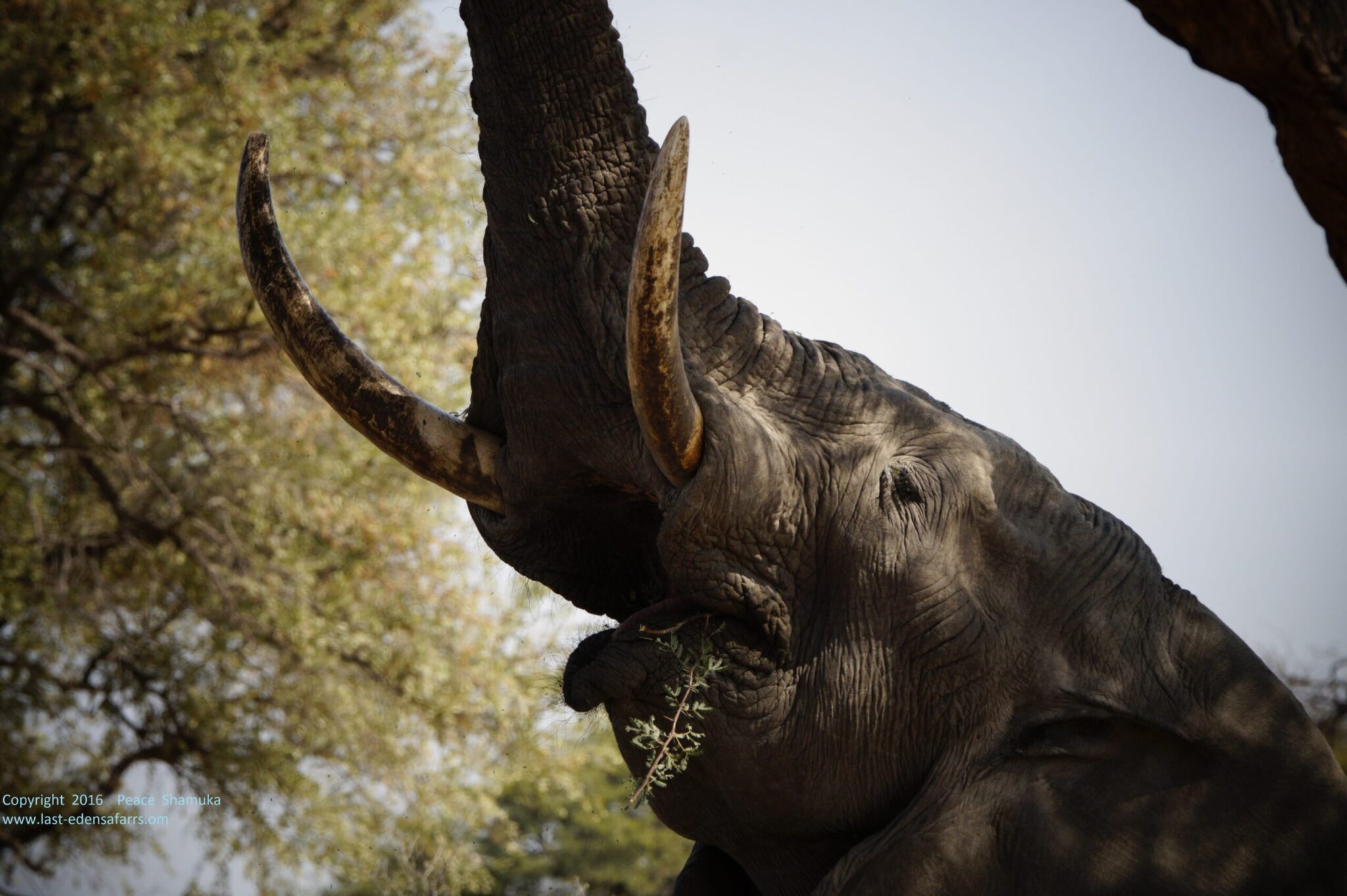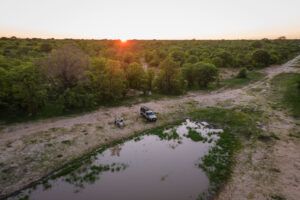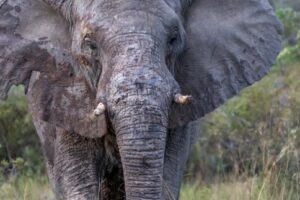Chobe National Park, situated in northern Botswana, is one of Africa’s most iconic wildlife destinations.
One fact remains prevalent and fascinating. The park spans over 11,700 square kilometers, approximately the size of Northern Ireland. This place is home to the largest concentration of elephants on the continent, with recent estimates placing their numbers between 50,000 and 120,000.
This vast and diverse park offers unparalleled opportunities for wildlife enthusiasts to witness majestic creatures bathing in the Chobe River, explore lush floodplains, and experience thrilling encounters with predators. The park is renowned for its large elephant population, one of the largest in the world.
Whether you’re a seasoned safari-goer or planning your first African adventure, Chobe National Park promises an unforgettable Chobe safari experience filled with abundant wildlife, breathtaking landscapes, and rich biodiversity.
This blog will guide you through everything you need to know to plan your perfect safari in Chobe National Park, including key areas to explore, best times to visit, accommodation options, and exciting safari activities.
Overview of Chobe National Park
Chobe National Park is one of the premier destinations for an African safari, offering unparalleled wildlife viewing opportunities and diverse landscapes that captivate visitors from across the African continent.
Located in northern Botswana, this vast national park is renowned for its large elephant herds and rich biodiversity along the lush Chobe Riverfront. A visit to Chobe National Park is a must for any wildlife enthusiast, combining the thrill of wildlife encounters with the tranquility of pristine natural habitats.
Some of the key areas in the Chobe National Park include:
Chobe Riverfront
The Chobe Riverfront is the park’s most visited area, renowned for its lush floodplains and dense forests, which attract a diverse range of wildlife. This area is home to some of the largest elephant herds in Africa, earning Chobe its nickname as the elephant capital.
Visitors can enjoy boat cruises along the river, which provide unique perspectives on the park’s wildlife and scenery. River cruises are ideal for spotting animals congregating at the water’s edge and capturing breathtaking photos of majestic creatures as they bathe in the river.

The Chobe Riverfront also offers excellent birdwatching opportunities, with species such as African skimmers, fish eagles, and kingfishers commonly sighted.
Savuti Marsh
Savuti Marsh is a dramatic and predator-rich region within Chobe National Park. Known for its open plains and periodic water flow, this area supports a high density of lions, hyenas, leopards, and wild dogs.
The Savuti region is famous for thrilling predator-prey interactions and offers a more remote and wild safari experience.
Linyanti Marshes
The Linyanti Marshes provide a serene and less crowded safari destination. Characterized by lush floodplains and woodlands, this area is home to large herds of elephants, hippos, and rare antelope species, including the sable and roan.
Birdwatchers also find the Linyanti region rewarding due to its diverse avian population.
Serondela Area
Located near the park’s northern boundary, the Serondela area boasts a rich biodiversity, with common sightings of impalas, warthogs, zebras, and occasional big cats.
It offers a diverse mix of habitats, including riverine forests and open grasslands, making it an excellent spot for observing a wide range of wildlife.
Mababe Depression
Situated south of Savuti, the Mababe Depression is a less-visited part of the park accessible via the Mababe gate.
It features a mix of wetlands and dry areas, supporting a variety of wildlife and offering a quieter safari experience for those seeking solitude and adventure.
Nogatsaa Area
Nogatsaa is a remote and rugged region in the southwestern part of Chobe National Park. It is known for its dry landscape and sparse vegetation, attracting species adapted to arid conditions. This area is ideal for experienced safari-goers looking to explore off-the-beaten-path locations within the park.
As one of the most popular national parks in Southern Africa, Chobe attracts visitors from around the world for its exceptional game viewing and photographic safaris.
Whether you’re seeking majestic creatures bathing in the river, spectacular elephant sightings, or vibrant birdlife, including African skimmers and fish eagles, Chobe offers a unique safari experience that is hard to match.
Geography and Climate
Covering an expansive area of over 11,700 km², roughly the size of Northern Ireland, Chobe National Park is Botswana’s first national park, established in 1968, and one of the largest protected areas in Africa.
The park’s geography is defined by the Chobe River, which forms its northern boundary and provides a vital water source for the region’s wildlife.
The park also features diverse habitats, including the Savuti Marsh, renowned for its dramatic predator-prey interactions, and the serene Linyanti Marshes, which offer a quieter and more remote safari experience.
The Chobe River is home to hippos, crocodiles, and the occasional tigerfish, adding to the park’s rich aquatic biodiversity.
Chobe’s climate is generally warm and dry, with a distinct dry season from May to October, considered the peak safari season. The best time to visit Chobe National Park is during the cool, dry season, when water-dependent animals congregate near the river and remaining waterholes, providing excellent opportunities for wildlife sightings.
The rainy season from November to April brings lush greenery and new life to the park, but game viewing can be more challenging due to denser vegetation and muddy roads.
Planning Your Chobe Safari
Planning a Chobe safari involves selecting the right time of year, accommodation, and safari activities to suit your preferences and budget.
The dry season, from May to October, is the ideal time to visit, as wildlife congregates around water sources, making game drives and boat cruises particularly rewarding.
Accommodation options range from luxury lodges, such as the iconic Chobe Game Lodge and Ngoma Safari Lodge, to more rustic camping safaris and mobile safaris. Whether you prefer the comfort of lodge safaris or the adventure of camping under the stars, Chobe offers something for every traveler.

Ideal accommodations include options both inside and outside Chobe National Park, catering to all budgets.
Safari activities include land safaris such as game drives and walking safaris, as well as boat safaris on the Chobe River.
The safari boats offer a unique vantage point to observe hippos, crocodiles, and elephants bathing in the water, while walking safaris provide an intimate connection with the wilderness and opportunities to spot elusive predators, such as African wild dogs.
Accommodation Options to Access Chobe National Park
Chobe Mopani Forest Lodge is a standout safari lodge located within the Kasane Forest Reserve, just a short distance from the main areas of Chobe National Park.
Nestled amidst dense mopane forests, this lodge offers guests an exclusive and intimate safari experience that strikes a balance between comfort and proximity to nature.
Guests enjoy spacious, well-appointed rooms featuring private decks that overlook the tranquil forest, providing a peaceful retreat after a day of wildlife viewing. The lodge boasts excellent amenities, including a swimming pool, stylish lounge areas, and a restaurant serving gourmet dishes inspired by local flavors.
Its setting within the Kasane Reserve allows easy access to Chobe National Park’s diverse ecosystems. Skilled guides lead game drives and walking safaris through the surrounding mopane woodland, where visitors can encounter elephants, lions, leopards, and a variety of rare bird species.
Additionally, the lodge arranges boat safaris on the nearby Chobe River, offering guests the chance to witness majestic creatures bathing and a rich array of aquatic wildlife.
Ideal for wildlife enthusiasts and photographers seeking a more secluded and immersive experience, Chobe Mopani Forest Lodge combines the excitement of the Chobe safari experience with the serenity of its forest environment.
Safari Activities
Chobe National Park offers a variety of safari activities tailored to different interests.
Game Drives
Game drives in open 4×4 vehicles are the classic way to explore Chobe’s diverse ecosystems. Early morning and late afternoon drives maximize wildlife viewing, with opportunities to see large herds of elephants, cape buffalo, lions, leopards, and a myriad of bird species. The dry season is gratifying as animals congregate near waterholes.
Boat Safaris
Boat safaris on the Chobe River are among the most popular activities. These river cruises offer a relaxing way to observe aquatic and water-dependent animals, including hippos, crocodiles, and elephants, as they bathe. The calm waters also attract a variety of birdlife, such as African skimmers and fish eagles, making boat trips a favorite for wildlife photography.
Walking Safaris
Walking safaris are not permitted within the official boundaries of Chobe National Park itself due to safety regulations of the Department of Wildlife and National Parks. You can, however, experience guided walks in the Kasane Forest Reserve led by experienced guides.
Walking safaris provide an intimate experience of the bush, allowing visitors to learn about animal tracks, plants, and smaller wildlife.
Wildlife and Conservation
Chobe National Park supports an extraordinary array of wildlife, including the largest concentration of elephants in Africa, with an estimated population of 50,000 to 120,000 individuals. Large herds of elephants, Cape buffalo, and other herbivores roam the park, attracting predators such as lions, leopards, and hyenas. The park is also a sanctuary for endangered species, including African wild dogs and cheetahs. Additionally, visitors can spot large herds of Cape buffalo, zebra, giraffe, and various antelopes, including the rare puku, impala, sable, and roan.
Conservation efforts in Chobe focus on anti-poaching, habitat preservation, and community engagement. Visitors can support these initiatives by choosing responsible safari companies that prioritize sustainable tourism and adhere to park rules designed to protect wildlife.
Health and Safety
While Chobe National Park is generally considered safe for visitors, taking precautions is advisable. Visitors should always follow park rules and stay with their guides to avoid dangerous wildlife encounters. Malaria is prevalent in the region, so prophylaxis and insect repellent are essential.
Sun protection, hydration, and awareness of environmental hazards all contribute to a safe and enjoyable safari experience. It is also advisable to have travel insurance and carry a basic first aid kit.
What to Pack for a Chobe Safari
Packing for a Chobe safari requires practical and comfortable clothing. Neutral-colored, breathable fabrics help blend into the environment and deter insect attraction. Layering is essential for adapting to warm days and cool mornings or evenings.
Essential items include sun protection (such as sunscreen, a hat, and sunglasses), insect repellent, binoculars, and a camera with extra batteries. A refillable water bottle and portable charger are also recommended.
Combining Chobe with Other Destinations
Chobe National Park is ideally situated for combining with other iconic Southern African destinations. Visitors often combine a Chobe safari with a visit to Victoria Falls, accessible via Kasane International Airport or Victoria Falls Airport, offering spectacular waterfalls and additional wildlife experiences.
The Okavango Delta and Moremi Game Reserve are nearby wilderness areas that complement Chobe’s safari offerings with unique ecosystems and wildlife viewing opportunities. Multi-day safaris that include these destinations provide a comprehensive African safari experience.
Day tours from Kasane or Victoria Falls can also be arranged to explore Chobe’s highlights, making it accessible for travelers with limited time.
This detailed guide to Chobe National Park aims to help you plan your perfect safari, from understanding the park’s geography and wildlife to choosing the best activities and accommodations. Whether you’re embarking on a private safari, a self-drive safari, or a fly-in safari, Chobe promises unforgettable wildlife encounters and memories to last a lifetime.
Frequently Asked Questions (FAQ) about Chobe National Park
What is the best time to visit Chobe National Park?
The best time to visit Chobe National Park is during the dry season, from May to October. During this period, water-dependent animals congregate near the Chobe River and other water sources, offering excellent wildlife viewing opportunities. The peak safari season falls between July and October when game viewing is at its best.
How do I get to Chobe National Park?
The most convenient way to reach Chobe National Park is by flying into Kasane International Airport, which has regular connections to major cities like Johannesburg and Victoria Falls. Kasane International Airport is the closest airport to Chobe National Park, located just a few minutes away. Alternatively, you can drive to the park via several entry gates, including Sedudu Gate near Kasane, Mababe Gate near Maun, and Ngoma Gate near the Namibian border.
What types of safari experiences are available in Chobe?
Chobe National Park offers a variety of safari experiences including game drives, boat safaris on the Chobe River, walking safaris, and fly-in safaris. Most visitors choose to either take guided trips or self-drive through Chobe National Park. A 4×4 is required for self-driving through the park due to the sandy terrain, making it essential to plan accordingly.
Are there park fees to enter Chobe National Park?
Yes, visitors are required to pay park fees to enter Chobe National Park. These fees contribute to conservation efforts and park maintenance. The fees vary depending on the length of stay, type of safari, and nationality of the visitor. It is advisable to check the latest park fees with your tour operator or at the park entrance.
Can I visit local villages near Chobe National Park?
Yes, some safari operators offer cultural tours to local villages near Chobe National Park. These visits provide insight into the traditional lifestyles of local communities and support community-based tourism initiatives. Always book these tours through reputable tour operators to ensure a respectful and authentic experience.
What wildlife can I expect to see on a Chobe safari?
Chobe National Park is renowned for its abundant wildlife, including large herds of elephants, Cape buffalo, lions, leopards, African wild dogs, and a diverse array of antelope species. The Chobe Riverfront area is primarily known for its spectacular elephant sightings and diverse birdlife, including African skimmers and fish eagles.
Is Chobe National Park suitable for day trips?
Yes, the Chobe Riverfront area is accessible for day trips, especially from Kasane or Victoria Falls. Day tours typically include game drives and boat cruises, allowing visitors to experience the park’s highlights even with limited time.
What should I pack for a safari in Chobe National Park?
We recommend packing lightweight, neutral-colored clothing, sun protection (including a hat, sunscreen, and sunglasses), insect repellent, comfortable walking shoes, binoculars, and a camera. Layered clothing is advisable to accommodate warm days and cooler mornings or evenings, especially during boat safaris and early game drives.
Can I combine a visit to Chobe National Park with other destinations?
Absolutely. Many travelers combine Chobe safaris with visits to Victoria Falls, the Okavango Delta, and Moremi Game Reserve. These multi-destination itineraries provide a diverse and enriching Southern Africa safari experience.
